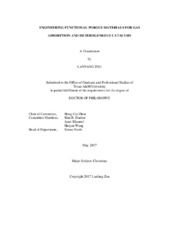| dc.description.abstract | In the past two decades, functional porous materials have gained tremendous attention in scientific and technological research. Metal-organic frameworks (MOFs) and porous polymer networks (PPNs) emerged as novel categories of porous materials with ultrahigh porosity, enormous surface area, tunable pore size and shape, and adjustable functionalization. Hence, MOFs/PPNs have demonstrated great potential for gas adsorption and heterogeneous catalysis, which has been my research focus.
Firstly, utilizing labile MOFs as templates, a general post-synthetic method was invented to synthesize a series of Ti-MOFs. The crystallinity of these Ti-MOFs was well maintained throughout, as confirmed from powder X-ray diffractions and gas adsorption measurements. This work provides a first time reported systematic strategy to construct Ti-MOFs while highlighting the potential of Ti-MOFs in photocatalytic applications.
Two stable porphyrin based PPNs have been synthesized through a facile one-pot approach by the aromatic substitution reactions of pyrrole and aldehydes. Among them, PPN-24(Fe) performs high catalytic efficiency as a biomimetic catalyst for the oxidation reaction of 2, 2’-azino-bis(3-ethylbenzthiazoline-6-sulfonic acid) (ABTS) in the presence of H2O2.
In next section, we report the design of a flexible Zr-MOF system, namely PCN-700 series, for the realization of switchable catalysis in cycloaddition reactions of CO2 with epoxides. The breathing amplitudes of the PCN-700 series are magnified through pre-functionalization of organic linkers and post-synthetic linker installation. Experiments and molecular simulations confirm that the catalytic activities of the PCN-700 series can be switched on and off upon guest-induced reversible structural transformation.
MOFs have become a burgeoning field of research and a great potential candidate for hydrogen storage. As way of example, MOFs constructed by carboxylate, azolate or mixed linkers, are discussed in the context of hydrogen storage. Last but not least, the post-synthetic modifications on MOF materials to increase the hydrogen storage capacities will be carefully illustrated.
Intensive efforts have been made to investigate PPNs as one type of the most promising candidates for carbon capture. A detailed correlation study between the structural and chemical features of PPNs and their adsorption capacities will be discussed, mainly focusing on the physical interactions and chemical reactions. | en |


